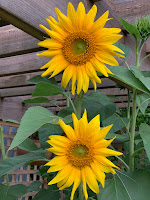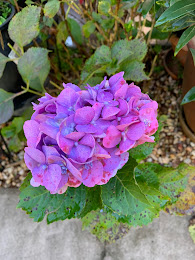Recently my sister Doreen in the USA posted this old photo taken (I think) early in 1974 of some members of our family. She sent it round to her three daughters, two of whom (twins) were in utero at the time!
 |
| Brother Paul with Fritz, brother-in-law John holding his daughter Raina and my daughter Zoe, sister Doreen, and Mum and Dad. |
In fact I can clearly remember taking this photo of some of the family I was about to leave forever - or so it seemed 49 years ago. Another sister, Nancy, was no longer living near enough to join us on this day. And my then-husband was on one of his final workdays, prior to our scheduled emigration to Australia. I had little expectation then that family would ever visit me on the other side of the world, as both of my parents and then Doreen later did several times. Or that my mother would spend one of her final years with me not long before she died. I certainly didn't expect I would end up working in jobs that would allow me regular visits 'back home' over many years. Or that Nancy would one day join me in Australia, along with her family. So the day that this photo was taken was a sad one for me, even if I was also looking forward to a new life in Australia.
My brother had driven my daughter and me down to Doreen's little farmhouse in Preston, Connecticut - which she and her husband had bought not long before. One reason I probably remember the day so well is because this was the winter of the great Oil Crisis in the States. Some State Governments had decided to lower the speed limit on freeways and highways to 50mph (80.5km) because that was deemed to be more fuel-efficient than the usual 60mph. I don't think my brother was very happy about that temporary regulation - even though we weren't then travelling in one of the sportscars that he would later keep tucked away in his garage throughout the winters (and I think still does!)
 |
| Zoe at Cheney's Apple Farm1973 |
I suppose it was a drive of just over an hour from where my parents and brother lived in Massachusetts. By then, I think I would have been staying with my parents as my husband and I were getting ready to leave the country for good. We had spent almost a year living nearby after returning from our first three-year stint in Australia. We'd come 'home' from those firsts few years in Oz with a child and no intention of going back. Fate decided otherwise. And glad am I for that. But that's a story for a different post.
After seeing that family photo this week, one of Doreen's daughters (my niece) sent me this message: "Wow, can't believe you have been in Australia for so long. Crazy." Personally, I can't believe there was ever a time when I wasn't in Australia. That's how strange it seems to me that I ever identified as American. And when I became an Australian citizen at an Australia Day Ceremony, on 26 January 1976, dual USA/Australian citizenship was not allowed. So becoming Australian meant renouncing US citizenship.
 |
| Our first home as "new Australians": Glasslough, Epping Forest, Tas. |
On 27 January 1976 - the day after the Mayor of Glenorchy, Tasmania, granted my Australian Citizenship Certificate at that ceremony - the Tasmanian Branch of the Australian Department of Immigration sent a letter to the US Embassy in Canberra, informing them I was now an Australian citizen. But it wasn't until two years later that I received a registered letter from the US Consulate in Melbourne, informing me that Section 349(a)(1) of the Immigration and Nationality Act states that "a person who is a national of the United States whether by birth, or naturalization shall lose his nationality by (1) obtaining naturalization in a foreign state upon his own application..." The letter included forms which we were supposed to sign and return. And I'm pretty sure I did so...
...because in May 1978 I received a "Certificate of Loss of Nationality of the United States". Nowadays both the USA and Australia allow dual citizenship. So my daughter has retained both the US citizenship she inherited by birth, and the Australian citizenship she gained when we were naturalised. Did I care about losing US citizenship? Not in the least. Not then or ever since - though I admit it would have been easier to be a US citizen when I later travelled back and forth to spend time with my ageing parents. I very nearly overstayed the three-month visitor's visa on one occasion.
What surprises me most now is that I'm sometimes treated as if I'm still quasi-American. People who don't know me well - but have some knowledge about my background - will often apologise to me after saying something slightly critical about the United States. Yet I'm probably more critical than anyone about certain US policies and practices - about health care, for example. And don't even mention Trump! I can't help feeling very lucky to be Australian - though that doesn't mean I'm not also critical about some of my adopted country's policies and practices. Take the ongoing incarceration of refugees who arrive illegally by boat. Truth is: there is plenty that needs fixing in both countries.
I just happen to think that ours is in so many ways a better environment in which to live and work. Maybe not for everyone - but for a larger percentage of the national population than is the case in the USA. I'm not sure I thought about that in 1976, when we left the States for good. Our reasons for leaving were entirely personal, not social or political. But we must have had some inkling that we could make a better life here. It's now 53 years since I first came to Australia - and 47 years since Zoe and I became citizens. That's what I celebrate on Australia Day!







.JPG)



















.jpeg)




.jpg)



















